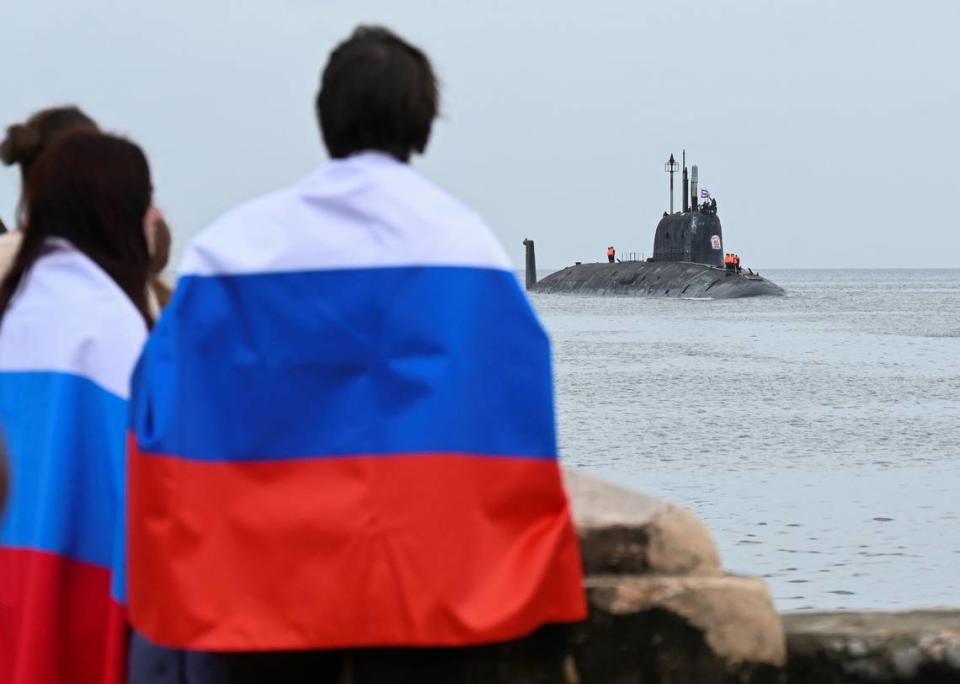A group of Russian warships that sailed close to Florida shores, closely watched by U.S. destroyers, entered the port of Havana on Wednesday morning ahead of Russian military exercises in the Caribbean.
Cuban Revolutionary Armed Forces officials, including the deputy commander of the Revolutionary Navy of Cuba, Capt. Jose Luis Souto Galindo, the Russian ambassador to Cuba Victor Koronelli and a crowd of Russian tourists and curious Cubans gathered at the Malecon, the famous Havana seaside promenade, to watch the Russian missile frigate Admiral Gorshkov enter the port amid a 21-gun salute.
Early on Wednesday, the top of the nuclear-powered submarine Kazan was visible outside Havana Harbor before it submerged again, Cuban independent media 14ymedio reported.
The official Russian government news agency Tass reported Wednesday that the Kazan, a modern nuclear submarine, is capable of “quietly approaching U.S. shores within 50 km and carrying out assigned combat missions,” according to Mikhail Budnichenko, the head of Sevmash, the company that built it.
Open-source satellite data placed the Russian warships just 26 nautical miles from Key Largo on Tuesday morning.
According to Tass and Interfax, a private Russian news agency, the submarine is equipped with Zircon hypersonic missiles. Zircons travel so fast — nine times the speed of sound, or close to 7,000 miles per hour — that one could hit the United States in seconds from Havana.
However, it is unclear if the Kazan carried Zircons while visiting Cuba. Cuban authorities have said the Russian combat vessels do not carry nuclear weapons and do not represent a threat to the region’s security.
The presence of the Russian warships in Cuba just 90 miles from U.S. shores, is seen as a gesture of defiance by Vladimir Putin, who last week warned about taking “asymmetrical” steps and the possibility of sending long-range weapons to third countries to attack Western targets after President Joe Biden allowed Ukraine to use U.S. weapons to strike inside Russia.
Speaking to reporters Wednesday, National Security Adviser Jake Sullivan said the U.S. government has not seen evidence that Russia is placing in or delivering missiles to Cuba.
“We have not seen anything like that,” he said.
The senior official said Russian ships have also been sailing to Havana under past administrations, though this visit has “elements…that are different, that are distinct,” he said in a reference to the Kazan submarine.
The presence of Russian warships in Cuba is “something we watch closely, carefully,” he added. “We will see how this unfolds in the coming days, but we have seen this kind of thing before.”
The Biden administration has dismissed the Russian naval movements as a messaging tactic in response to U.S. support for Ukraine. But the U.S. Navy nevertheless deployed a powerful flotilla in response, sending three destroyers, a Coast Guard cutter and a maritime surveillance plane to stalk the Russian vessels.
U.S. deploys warships as Russian fleet makes close pass to Florida in approach to Cuba
U.S. officials confirmed to McClatchy and the Miami Herald on Tuesday that the U.S. warships were deployed to “ensure the defense of the United States and Canada.”
“Russia’s deployments are part of routine naval activity which pose no direct threat or concern to the United States,” an official with U.S. Northern Command said.
But last year Air Force Gen. Glen Van Herck, at the time the chief of the U.S. Northern Command, told Congress that the Russian deployment off the U.S. coasts of Yasen-class cruise-missile submarines like the Kazan is causing growing concern.
“Now not only the Atlantic, but we also have them in the Pacific, and it’s just a matter of time – probably a year or two – before that’s a persistent threat, 24 hours a day,” Van Herck told a congressional hearing.
Russian warships, including nuclear sub, missile frigate, will arrive in Cuba next week
The Cuban military said last week that the Russian fleet, including the oil tanker Pashin and the salvage tug Nikolai Chiker, will stay for a week. A Canadian ship will also dock at the port of Havana on Friday, coinciding with the Russian combat vessels.
U.S. officials said the Russian ships may also make a stop at a Venezuelan port. A Venezuelan ship, the AB Simón Bolívar, will also visit Santiago de Cuba, the island’s second-largest city, between June 15 and 19.
The Tass news agency said the Russian delegation is headed by Vice Admiral Mikhail Neupokoev, head of the operational department of the Russian navy.
Russia has strengthened its military alliance with Cuba in recent years, with high-ranking military and intelligence officials making frequent visits to Havana. For many years, Russia operated a spy base near Havana in Lourdes, but the facility was dismantled in the early 2000s.
While the Russian ships were entering Cuban waters Wednesday morning, Cuban Foreign Minister Bruno Rodriguez was meeting his Russian counterpart, Sergei Lavrov, in Moscow. The two men vowed to continue supporting each other’s agenda but did not mention the ships’ arrival in Havana.


